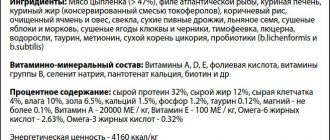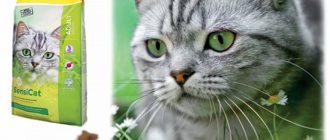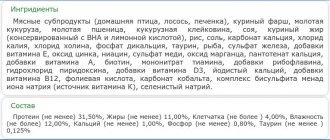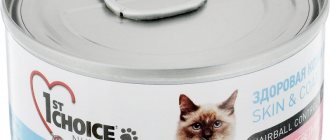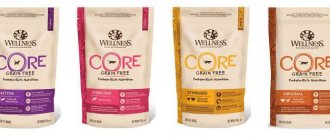Why do cats have allergies?
Allergic reactions occur when an animal’s immune system perceives any substance in the body as an “enemy” and provokes the release of special antibodies into the blood - class E immunoglobulins. These substances are responsible for protecting the skin and mucous membranes from external threats. Therefore, in case of allergies, a cat’s “weak points” are the respiratory system, eyes, ears and nose, digestive system and fur of the purr. After all, during the fight against an allergen, an inflammatory process begins against the background of the production of histamine, a tissue hormone that gives a “signal” to the onset of an allergic reaction.
Allergies in cats include sneezing and watery eyes.
Allergies can be triggered by caustic household chemicals or tobacco smoke, but sometimes other factors also come into play:
- heredity - pathological reactions to external stimuli often occur in purebred cats or kittens from “mixed marriages”, especially if one of the parents had a tendency to allergies (the reason is weakened immunity against the background of gene mutations that arise during selection);
- weakening of the body's protective functions - possibly due to suffering a serious illness or unfavorable living conditions (hunger, freezing or constant stress);
- violation of the diet - a lack of meat in the cat’s menu and a lack of regular nutrition lead to deterioration of health and the occurrence of allergies, which can also be caused by low-quality ready-made food;
- choosing inappropriate cosmetics for your animal - substances included in shampoos and conditioners can be strong allergens;
- side effects of medications - the body of a healthy cat can react negatively to virus strains during vaccination, and in sick animals allergies are often caused by medications.
Scientists have not yet identified the exact causes of allergies in cats, so threats can be expected from everywhere. It is important to remember that each animal is individual, so it is quite difficult to predict the occurrence of a reaction in advance.
An allergy in a cat can occur to pet care products and manifest itself in the form of inflammation on the skin with blisters and ulcers.
Allergens for cats are:
- discharge of ectoparasites (fleas, ticks) and other biting insects;
- mold and pollen;
- dust;
- cat litter;
- particles of fur, secretions or dander from other pets;
- groups of cells in your own body.
Video: allergies in animals
Main reasons
An allergy is a particularly pronounced reaction of the body to various components of food additives. Cats, just like people, are not immune to this problem.
Among the most common causes of allergic reactions are:
- Bad ecology.
- Cheap and low-quality food.
- Parasites in the body.
- Various gastrointestinal infections.
- Weak immunity.
- Predisposition from parents.
Symptoms of a food allergy
The symptoms of a food allergy are very similar to those of other allergic reactions. But it is still possible to find differences in order to accurately rule out other allergic reactions. The most common symptoms of food allergies include:
- Skin itching. It appears on the face, paws, ears and even on the stomach.
Skin itching. - Unusual discharge. You may notice frequent discharge from the nose, ears and even eyes.
The nose of a healthy cat. There are no traces of discharge.
- Sweating. If you notice that the fur in the armpit area is often damp, this indicates increased sweating of the animal.
- Bald spots. Due to the permanent tooth, areas of the skin appear bare of fur. If this is not treated in time, wounds and ulcers appear on open areas of the skin.
A cat has a bald spot.
- Swelling. In later stages, swelling of the extremities, heavy breathing, and cough are possible.
Do not confuse food allergies and food intolerances, the symptoms of which are nausea, vomiting and loose stools.
Diagnostics
If you notice even the slightest signs of an allergy, you should immediately consult a doctor. It is the veterinarian who will be able to make the correct diagnosis and protect your animal from possible danger due to this disease.
When contacting a doctor, he conducts a thorough examination of the cat. Some types of allergies can be identified by the nature of the wounds and bald spots. Next, a blood test and scraping of the damaged skin are taken from the cat.
Special diet for cats
It is easier for a person to find out what exactly he is allergic to. But the cat is transferred to a specially designed diet for 3 months.
This is necessary to determine the allergen. During the diet, one or another food is introduced into the animal’s diet and the reaction is observed. If you strictly follow the doctor's rules, then food allergies are detected quite simply.
It is dangerous to treat your pet at home, as it may not be allergic to food at all. Only in a clinical setting can appropriate tests be carried out that will confirm the presence of food allergies and exclude other possible factors.
Types of allergies in cats
There are several classifications of pathological reactions of cats’ immunity to external stimuli. Thus, allergies are usually divided into food and non-food. The first appears due to the body's rejection of protein contained in meat dishes and milk derivatives, as well as in eggs, cereals and vegetables (for example, soy or legumes). If the finished food contains such a component, you need to carefully monitor the pet’s condition in order to detect symptoms of possible intolerance in time.
Allergies provoke the appearance of itchy areas on the skin, which forces the cat to scratch the affected areas until they bleed.
The second type of allergic reactions includes hypersensitivity to a protein found in the saliva of blood-sucking insects (including parasites), as well as intolerance to household chemicals (allergy to silicates or bentonite clay in tray fillers, plastic, fabric or perfume). This also includes reactions to bee or wasp venom, as well as snake bites.
More specifically, allergies in cats are determined by classification depending on the type of irritant:
- atopic - appears due to genetically determined susceptibility to any source of irritation (household dust, food, medications, mold);
- chemical - occurs on cleaning products, shampoos, powders, litter for toilets and cosmetics for animals;
- infectious - possible against the background of an infectious disease due to damage to the body by fungi, pathogenic microbes and viruses;
- parasitic (insect) - associated with the vital activity of cat parasites (fleas, lice, ticks and helminths).
An allergy to fleas is life-threatening for a cat, because one parasite can bite a purring cat up to 200 times a day.
Based on the location of the lesion due to contact with the antigen (irritant), allergies in cats are divided into:
- autoimmune - when the immune system “declares war” on certain groups of cells of its own body;
- contact - in this case, a reaction occurs when an allergen comes into contact with the skin and fur of an animal;
- respiratory - allergies begin from the penetration of irritating substances into the cat's respiratory tract.
Video: food allergies in cats
Causes of allergies to Royal Canin
If your cat is allergic to Royal Canin, you won’t have to spend a lot of time identifying it. The thing is that such an allergy is quite easily detected. The pet loses its former energy, becomes lethargic and lacking initiative. Often the animal does not eat anything and spends most of its time lying down. The cat's stool may change from solid to liquid, and the owner may also experience constant vomiting from the cat. In such cases, you must immediately consult a doctor to make an accurate diagnosis.
An allergy to Royal Canin occurs due to the fact that the composition of this food cannot be called 100% balanced. The thing is that the manufacturer adds by-products, corn flour, and a variety of animal fats as components. Pets with sensitive digestion react sharply to the presence of offal or corn flour in food, which is, in principle, very difficult to process. That is why you should consult a veterinarian before adding Royal Canina to your diet.
Complications can also arise if a person uses the wrong line of food. Kittens must be fed exclusively with food designed for babies. Royal Canina also has developed lines for individual breeds, and veterinarians recommend buying the most suitable food for a particular pet.
They also have a special medicinal line, which is considered the most useful and is designed for cats with sensitive digestion. If your pet’s well-being is of great concern, it is recommended to give preference to this food.
Allergy symptoms in cats
The pathological reaction of the purring organism to the antigen is manifested by a number of signs common to all stimuli. Moreover, health problems may be associated with other diseases, so it is better not to self-treat your pet. Only a diagnosis carried out by a veterinarian will reveal the true cause of a cat’s poor health.
Tears in your cat's eyes could be a sign of a chemical allergy.
Most often, allergies are expressed in the following:
- rashes and red spots on the skin;
- hair loss and swelling in certain areas of the body;
- scratching with blood due to constant itching;
- runny nose and sneezing, watery eyes;
- flaky skin on the paws (especially between the toes);
- labored breathing;
- constant vomiting, indigestion.
Also, individually, body temperature may increase, and in rare cases, anaphylactic shock with bronchial edema and respiratory spasms is possible.
Signs of allergies occur both individually and in combination. The time of manifestation also varies - the reaction can begin immediately after contact with the antigen or only after a few hours. Therefore, it is important not to delay your visit to the veterinary clinic in order to prevent the purr’s health from deteriorating.
In addition to general symptoms, there are also specific “markers” for different types of allergies in cats.
Thus, hypersensitivity to feed is characterized by:
- the appearance of inflamed and itchy areas on the body;
- rash in the form of grains;
- vomiting and stool upset;
- the appearance of bald spots.
With a flea allergy, an animal infected with parasites develops small inflamed areas on the skin and hives. Bloody wounds often begin to fester due to the proliferation of bacteria in the scratch area.
For a chemical allergy, the signs are:
- dermatitis in areas of contact with the irritant;
- the appearance of peeling and eczema on the paw pads and between the toes;
- baldness and itching (if the shampoo is not suitable);
- difficulty breathing and sneezing, swelling of the upper respiratory tract (if the cat sniffed the powder or inhaled the air freshener).
A rare and life-threatening pet disease - autoimmune allergies, is indicated by the following disorders:
- the appearance of crusts and matted hair on the skin (signs of pemphigus foliaceus);
- damage to internal organs due to systemic lupus erythematosus;
- the occurrence of nervous disorders (myasthenia gravis);
- inflammatory processes in several joints at once (typical of progressive polyarthritis);
- fatal breakdown of red blood cells due to autoimmune anemia.
Photo gallery: external manifestations of different types of allergies in cats
Autoimmune allergies in cats can cause a disease such as pemphigus foliaceus.
Contact allergy on a cat's paws is the result of hypersensitivity to floor cleaners or cat litter.
Food allergies in cats are accompanied by hair loss and swelling of certain areas on the body
An allergy to fleas leads to the fact that the cat scratches the bite sites to deep wounds
Chemical allergies in cats are characterized by inflammation and swelling in areas of contact with a caustic allergen.
What foods most often cause allergies?
Food allergies in cats most often occur due to feeding the following foods:
- dry food, which can be high-quality or cheap, a reaction is formed to the contained chemicals, dietary supplements or even vitamins;
- chicken, it is one of the most easily digestible foods, is deposited in many tissues, and can cause inflammation of the joints;
- Dairy products in cats, just like in humans, cause an increased reaction of the immune system;
- canned additives that allow long-term storage of cat food in tin packages;
- vegetables, cereals, various types of meat.
Allergy in a cat
Attention! A cat's allergy to food most often manifests itself in skin reactions and affects the quality of the coat, but a systemic disorder can also occur.
Allergy diagnosis
A veterinarian will help determine the cat’s hypersensitivity to any organism - the doctor will make a conclusion based on a survey about the pet and the course of the disease, as well as after collecting and conducting tests (general urine analysis, scrapings to identify fungi, blood tests).
Allergy tests in cats can give false results due to the lack of special tests for animals and the use of anesthesia
The specificity of diagnosing allergies in cats is that allergy tests can give erroneous results. This is due to the use of test kits for people as allergens, which is fraught with false results. Injecting 15–20 irritants under the skin of an animal is possible only under anesthesia, which is why the results of the study may also be incorrect. After all, all the administered drugs are mixed in the pet’s blood.
The only reliable method for determining allergies in a cat today is to exclude suspected allergens from its environment. So, if you have watery eyes and a runny nose, shortness of breath and constant sneezing in the house, stop using household chemicals (floor cleaners, air fresheners) for a while and change the brand of litter for the tray.
If there is a suspicion of a food allergy, the owner of the mustache is faced with the task of identifying the irritant among food products. The algorithm of actions here is as follows:
- The doctor recommends using hypoallergenic food for 12 weeks.
- After that, foods familiar to the pet are introduced into the diet one by one.
- The owner writes down the sequence of food administration in a separate notebook.
- If an allergic reaction occurs, the cat is examined by a doctor and prescribed medications.
- The veterinarian prescribes a diet that excludes the identified irritant.
Attentive owners discover seasonal allergies on their own during the flowering period. Hypersensitivity to plant pollen is especially evident in cats walking outside. If the relationship between a certain season and the appearance of a reaction in the purr is clearly visible, you need to contact a veterinary clinic to prescribe antihistamines.
What medicinal foods help with food allergies?
In most cases, kittens with food allergies are prescribed medicated foods that contain no allergens at all (even potential ones). The most common and popular are the following brands:
- Protect Dermato.
- Veterinary Diets HA St/Ox.
- Hypoallergenic DR25.
- Prescription Diet Feline z/d Ultra.
Their only drawback is the cost. But if you calculate carefully, feeding such food is even more profitable than good “natural” food. And there is no guarantee that the chicken or other meat that the owner buys for his pet will not contain the same antibiotics.
Treatment of allergies in cats
Getting rid of the disease begins by treating the itchy areas on the cat’s body with cortisone ointment or washing with a special antihistamine shampoo. This will make the animal feel better while visiting the veterinarian and diagnosing the allergy.
Hydrocortisone ointment - first aid for a cat when itchy areas appear on the skin
The following are measures to eliminate all possible irritants from the pet’s life. At the same time, medications with biotin (vitamin B7) are prescribed to restore the skin and improve the condition of the coat.
Veterinary drugs
After the cat has been prescribed a diet and a course of vitamin B7, the doctor selects antihistamines to block the effect of the antigen on the animal’s body.
Table: antihistamines for cats
| For animals | ||
| Name | Characteristics | Cost of the drug |
| Bravegil |
| 170 rub. |
| Dexafort |
| 1000 rub. |
| Pipolzin |
| 150 rub. |
| For man | ||
| Name | Characteristics | Cost of the drug |
| Diphenhydramine |
| 30 rub. |
| Loratadine |
| 250 rub. |
| Diphenhydramine |
| 40 rub. |
Photo gallery: allergy medications for cats
Diphenhydramine is traditionally used to treat allergies in cats
Dexafort - a powerful anti-allergenic remedy for purrs
Pipolzin can be used continuously in the treatment of seasonal allergies in cats
Loratadine is a third generation antihistamine with minimal side effects for cats.
Hypoallergenic diet
A special menu for a sick cat includes special food containing protein that has been broken down into amino acids and is no longer allergenic. This diet is selected by a veterinarian individually based on tests and examination of the animal.
To get rid of an allergy outbreak, you need to change your cat's diet.
The essence of the method is that the purr is prescribed food containing one source of protein of animal origin and one of plant origin. Moreover, these products must be new to the pet and not previously included in the menu. The diet lasts up to three months, and in addition to hypoallergenic food, it can only include clean drinking water.
Types of specialized food for allergies in cats:
- Royal Canin - has both dishes based on hydrolyzed soy protein (Hypoallergenic DR25) and those made from corn starch (Anallergenic);
- Hill's Prescription Diet z/d - the menu is based on rice and highly purified animal protein;
- ProPlan - the composition includes soy protein obtained by hydrolysis and rice flour;
- Brit Care - gluten-free meals contain rice, potatoes and lamb;
- Pronature Holistic - Gluten free, includes salmon, turkey and rice.
Photo gallery: hypoallergenic cat food
Canadian Pronature Holistic food is made from the purest natural ingredients
The entire line of Brit ready-made food is hypoallergenic
Hill's allergy food will help relieve the symptoms of the disease
Royal Canin food for cats with allergies is one of the most frequently prescribed
Anti-allergy food
For animals with allergies, food must meet the following requirements:
- good digestibility;
- balanced nutrient content;
- absence of allergens;
- ease of digestion;
- quality of ingredients.
Carefully developed in scientific laboratories, the formulas contain a small number of key ingredients.
If you are gluten intolerant, pay attention to the absence of wheat, corn, or soy on the label.
If you are hypersensitive to animal proteins, do not eat pork, chicken or beef. Well-digested meat of rabbit, lamb, and salmon is allowed.
When reacting to milk and eggs, the minimum content is suitable.
Dry food
List of different hypoallergenic food manufacturers
Today they produce a lot of hypoallergenic foods. Many people don’t like it because it doesn’t contain natural meat.
However, it is very popular. Here are the most common types:
- Royal Canin is hypoallergenic. It can not only remove itching, but prevent its reoccurrence.
- BILANX Sensitive. Has a positive effect on the stomach and skin.
- Purina HA Hypoallergenic Canine. Thanks to the multi-component recipe, you don’t have to worry about balancing the menu.
- Brit. Prevents problems from recurring in the future. The Yucca extract added to it reduces the odor from excrement.
- Pro Pac. Contains proteins and fats of natural origin, therefore it is very attractive. Does not contain chemical elements.
- Royal Canin Hypo HP is considered a top seller. The high cost is compensated by excellent quality. You can find it only in specialized pet stores.
When choosing, they take into account whether your furry pet likes the food or not. In the second case, she will simply refuse the offered treat.
We do not recommend buying food that is too cheap, as it contains a lot of by-products, which can only worsen the condition.
Treatment of allergies in kittens
Due to age, ridding a kitten of allergies is difficult due to the inability to use most antihistamines. Therefore, treatment of the disease here will involve eliminating possible irritants from the pet’s life.
Allergies in kittens manifest themselves in the same way as in adults.
The elimination diet lasts 7 days and consists of one type of meat and one type of plant food (vegetables, cereals) that the kitten has not yet eaten.
For a more accurate diagnosis, it is recommended to take a blood test, after which the doctor will prescribe steroids or suitable antihistamines. The safest and most frequently prescribed drug is Tavegil or its analogue, Bravegil. Veterinarians recommend treating itchy areas on the body with hydrocortisone ointment.
Types of feed and their features
According to generally accepted rules, feed is divided into types and classes. Each type and class of food must meet the requirements established by the international veterinary association. Naturally, not all manufacturers are honest with their customers; in addition, food is often counterfeited.
The following types of feed are distinguished:
- Dry – available in the form of granules.
- Semi-moist - pieces with gravy.
- Wet - pate or paste.
Note! Treats for cats are a separate, isolated type of food that is not part of the diet, but can serve as a source of vitamins or have a hygienic function.
Most manufacturers divide their products into individual lines:
- According to the age.
- According to the length of the coat.
- According to the degree of activity.
- By breed.
- According to individual characteristics - this particular line includes food for neutered cats, pets with allergies, animals suffering from sensitivity of the digestive tract, etc.
- Medicinal is a special, small line of food intended for use in combination with therapy aimed at combating a specific disease. Medicinal feeds must be prescribed by a veterinarian.
Industrial feeds are divided by class or quality:
- Economy class is the cheapest and lowest-quality segment, which causes food allergies in most kittens. Economy class food contains a large amount of preservatives, flavor enhancers and other chemical additives, to which the baby’s body reacts accordingly.
- Premium class is the most common segment for daily feeding of healthy animals. Premium food often causes allergies in kittens. The reason, most often, is the low-quality carbohydrate component or chicken, which is found in many types of premium feed.
- Super premium class is the optimal choice for daily feeding of pets; it extremely rarely leads to the development of food allergies and only in case of individual intolerance. Super-premium hypoallergenic foods contain special, “semi-processed” proteins that do not release toxins when broken down.
- Holistic class - by definition, this segment is hypoallergenic, but with individual sensitivity it can still lead to an allergic reaction. Within the holistic class, special, hypoallergenic foods that do not contain gluten are produced.
What to do if you are allergic to Royal Canin?
A cat food allergy usually does not go away easily, and owners have to completely eliminate this food from the animal’s diet. When choosing a new food for your pet, you should temporarily feed it with homemade food, after consulting with your veterinarian.
By taking a series of tests from the cat, the doctor will be able to identify which particular component the pet is allergic to. Having identified this very component, it will be possible to create an effective diet with a new food that will not contain this ingredient.
Usually, in case of an allergy to Royal Canin, experts recommend switching to food of a higher class. Super-premium food for an animal is not cheap, but it is guaranteed not to cause any problems with the functioning of the digestive system.
Thus, food from, “Nutram”, “Cimiao” and others are extremely popular. Their main advantage lies not only in the quality and naturalness of all ingredients, but also in the fact that such food for animals is produced mainly abroad. Abroad, they are usually more zealous about compliance with various quality standards. You need to transfer your pet to a new food gradually and wisely, first introducing a small amount of it, and only later completely switching to a new feeding algorithm.
Experts were able to reveal that allergies to wet cat food occur more often than to dry cat food, and this is due to the worst components in the first food option. That is why, if a cat has sensitive digestion, dry food should predominate in its diet.
Building the right diet for your pet so that it does not have any problems with the digestive system is not at all easy. However, a caring owner will spare no effort in searching for the ideal food, the use of which will not cause allergies.
The situation is this: my cat has MCD, he is 7 years old, not neutered, we have been undergoing treatment for two months already, we eat special food Royal Canin Urinari and Renal, mostly wet, but dry food also sometimes nibbles. Before the disease, he only ate natural food, so he eats dry food very it’s bad, but I only give it wet once a day, otherwise you can go broke, it’s very expensive... Yesterday I was petting him, and I felt some lumps under his fur, I looked more closely, and he had a lot of sores on his neck and head and even near his eyes crust - they are small, only 2-3 mm... He doesn’t itch at all, they don’t bother him when I touch them... I can only go to the doctor with him on Friday... I scoured the entire Internet, many write that cats have side effects from Royal , incl. allergies...Who had this? Maybe change the food? What good food do you recommend for urolithiasis?

